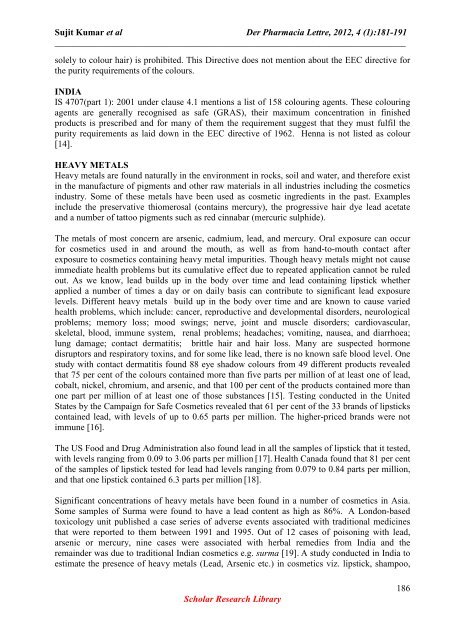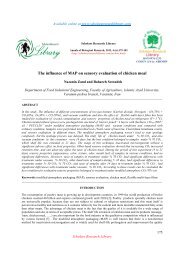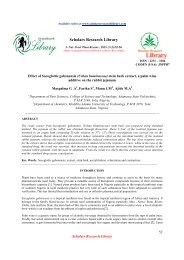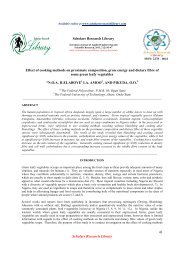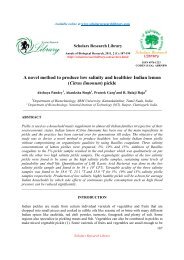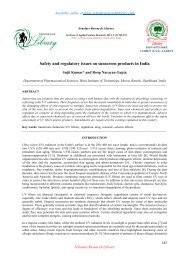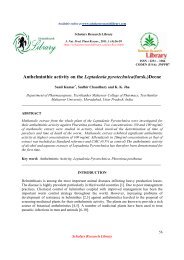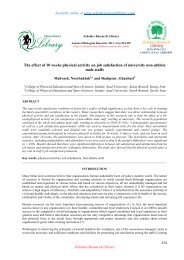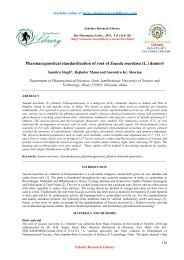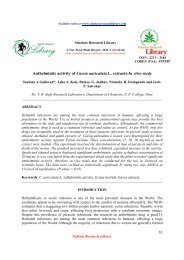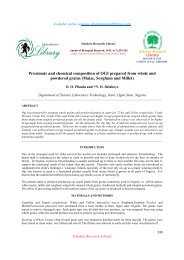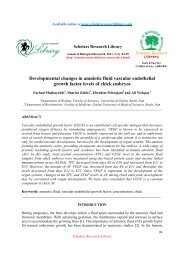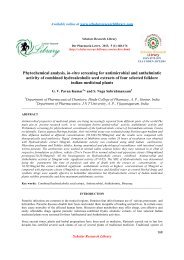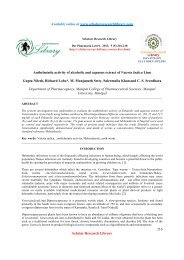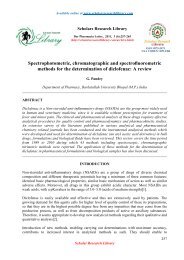Regulation for safety and quality of cosmetics vis - Scholars ...
Regulation for safety and quality of cosmetics vis - Scholars ...
Regulation for safety and quality of cosmetics vis - Scholars ...
Create successful ePaper yourself
Turn your PDF publications into a flip-book with our unique Google optimized e-Paper software.
Sujit Kumar et al Der Pharmacia Lettre, 2012, 4 (1):181-191<br />
_____________________________________________________________________________<br />
solely to colour hair) is prohibited. This Directive does not mention about the EEC directive <strong>for</strong><br />
the purity requirements <strong>of</strong> the colours.<br />
INDIA<br />
IS 4707(part 1): 2001 under clause 4.1 mentions a list <strong>of</strong> 158 colouring agents. These colouring<br />
agents are generally recognised as safe (GRAS), their maximum concentration in finished<br />
products is prescribed <strong>and</strong> <strong>for</strong> many <strong>of</strong> them the requirement suggest that they must fulfil the<br />
purity requirements as laid down in the EEC directive <strong>of</strong> 1962. Henna is not listed as colour<br />
[14].<br />
HEAVY METALS<br />
Heavy metals are found naturally in the environment in rocks, soil <strong>and</strong> water, <strong>and</strong> there<strong>for</strong>e exist<br />
in the manufacture <strong>of</strong> pigments <strong>and</strong> other raw materials in all industries including the <strong>cosmetics</strong><br />
industry. Some <strong>of</strong> these metals have been used as cosmetic ingredients in the past. Examples<br />
include the preservative thiomerosal (contains mercury), the progressive hair dye lead acetate<br />
<strong>and</strong> a number <strong>of</strong> tattoo pigments such as red cinnabar (mercuric sulphide).<br />
The metals <strong>of</strong> most concern are arsenic, cadmium, lead, <strong>and</strong> mercury. Oral exposure can occur<br />
<strong>for</strong> <strong>cosmetics</strong> used in <strong>and</strong> around the mouth, as well as from h<strong>and</strong>-to-mouth contact after<br />
exposure to <strong>cosmetics</strong> containing heavy metal impurities. Though heavy metals might not cause<br />
immediate health problems but its cumulative effect due to repeated application cannot be ruled<br />
out. As we know, lead builds up in the body over time <strong>and</strong> lead containing lipstick whether<br />
applied a number <strong>of</strong> times a day or on daily basis can contribute to significant lead exposure<br />
levels. Different heavy metals build up in the body over time <strong>and</strong> are known to cause varied<br />
health problems, which include: cancer, reproductive <strong>and</strong> developmental disorders, neurological<br />
problems; memory loss; mood swings; nerve, joint <strong>and</strong> muscle disorders; cardiovascular,<br />
skeletal, blood, immune system, renal problems; headaches; vomiting, nausea, <strong>and</strong> diarrhoea;<br />
lung damage; contact dermatitis; brittle hair <strong>and</strong> hair loss. Many are suspected hormone<br />
disruptors <strong>and</strong> respiratory toxins, <strong>and</strong> <strong>for</strong> some like lead, there is no known safe blood level. One<br />
study with contact dermatitis found 88 eye shadow colours from 49 different products revealed<br />
that 75 per cent <strong>of</strong> the colours contained more than five parts per million <strong>of</strong> at least one <strong>of</strong> lead,<br />
cobalt, nickel, chromium, <strong>and</strong> arsenic, <strong>and</strong> that 100 per cent <strong>of</strong> the products contained more than<br />
one part per million <strong>of</strong> at least one <strong>of</strong> those substances [15]. Testing conducted in the United<br />
States by the Campaign <strong>for</strong> Safe Cosmetics revealed that 61 per cent <strong>of</strong> the 33 br<strong>and</strong>s <strong>of</strong> lipsticks<br />
contained lead, with levels <strong>of</strong> up to 0.65 parts per million. The higher-priced br<strong>and</strong>s were not<br />
immune [16].<br />
The US Food <strong>and</strong> Drug Administration also found lead in all the samples <strong>of</strong> lipstick that it tested,<br />
with levels ranging from 0.09 to 3.06 parts per million [17]. Health Canada found that 81 per cent<br />
<strong>of</strong> the samples <strong>of</strong> lipstick tested <strong>for</strong> lead had levels ranging from 0.079 to 0.84 parts per million,<br />
<strong>and</strong> that one lipstick contained 6.3 parts per million [18].<br />
Significant concentrations <strong>of</strong> heavy metals have been found in a number <strong>of</strong> <strong>cosmetics</strong> in Asia.<br />
Some samples <strong>of</strong> Surma were found to have a lead content as high as 86%. A London-based<br />
toxicology unit published a case series <strong>of</strong> adverse events associated with traditional medicines<br />
that were reported to them between 1991 <strong>and</strong> 1995. Out <strong>of</strong> 12 cases <strong>of</strong> poisoning with lead,<br />
arsenic or mercury, nine cases were associated with herbal remedies from India <strong>and</strong> the<br />
remainder was due to traditional Indian <strong>cosmetics</strong> e.g. surma [19]. A study conducted in India to<br />
estimate the presence <strong>of</strong> heavy metals (Lead, Arsenic etc.) in <strong>cosmetics</strong> viz. lipstick, shampoo,<br />
Scholar Research Library<br />
186


